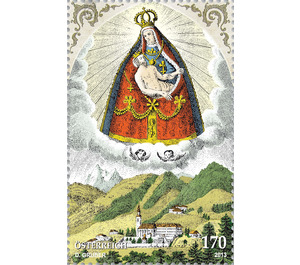500 years - Austria / II. Republic of Austria 2013 - 170 Euro Cent
Theme: History & Politics
| Country | Austria / II. Republic of Austria |
| Issue Date | 2013 |
| Face Value | 170.00 |
| Edition Issued | 170,000 |
| Printing Type | offset |
| Stamp Type | Commemorative |
| Item Type | Stamp |
| Chronological Issue Number | 2413 |
| Chronological Chapter | OOS-OE2 |
| SID | 612295 |
| In 25 Wishlists | |
For the 500th anniversary of the pilgrimage of Maria Luggau in the Carinthian Lesachtal, the post office congratulates with a brand block of a very special kind. The stamp, whose motive shows the Blessed Mother with the Savior and the lovely basilica embedded in the landscape, is given a white, with grinding perforation Top frame surrounded as an association of a holy little picture from days gone by. On the story: In 1513 a poor farmer's wife named Helena had a dream vision during the lunch break in the field, in which the grief mother encouraged her to build a chapel in this very place. Although the peasant woman did not attach importance to the strange event, she found no peace. Eventually, she decided to test the "truth" of the wondrous apparition, and the first witnessed miracle of candles happened: despite the stormy weather, she placed a burning candle on the field unprotected; If this really can withstand the thunderstorm without going out, this should be an appropriate sign. And indeed - the candle did not go out for three days. Now, the pious woman got a small, late Gothic Pietà, a simple work of pure folk art - the today famous Vesperbild the gracious mother of Luggau. In the beginning, of course, the peasant farmer was not supported by the neighborhood, on the contrary: Because of the candle miracle Helena was charged as a witch, but ultimately acquitted again. Newly encouraged, she then went to work with impetus and within a very short time the miraculous image was given a simple chapel. Another miraculous event made the Luggauer pilgrimage spontaneously popular: While a carpenter named Anton Mayrhofer covered the sanctuary, an obviously mentally ill wanted to steal the statue. When the carpenter snatched it from him at the last moment, he got the light of his mind again. The news of this miracle spread at lightning speed and attracted many pilgrims. Soon the chapel turned out to be far too small for the steady stream of pilgrims, and so Helena began to promote the construction of a larger church. At Schloss Pittersberg she found an advocate in the local administrator, who went to Luggau for a local inspection. Violent opposition brought him but from his plans, and so he resigned to the return journey. Halfway, however, his horse shied away and threw him off, his foot caught in the stirrup and he was dragged along by the wild horse. In panic fear of death the worried man called the Blessed Mother and vowed in case of his rescue the construction of the church in Luggau. His prayer was answered, the vow kept and on May 22, 1515 finally laid the foundation stone for the church. Today, 500 years later, about 40,000 pilgrims visit the well-known pilgrimage site every year.


